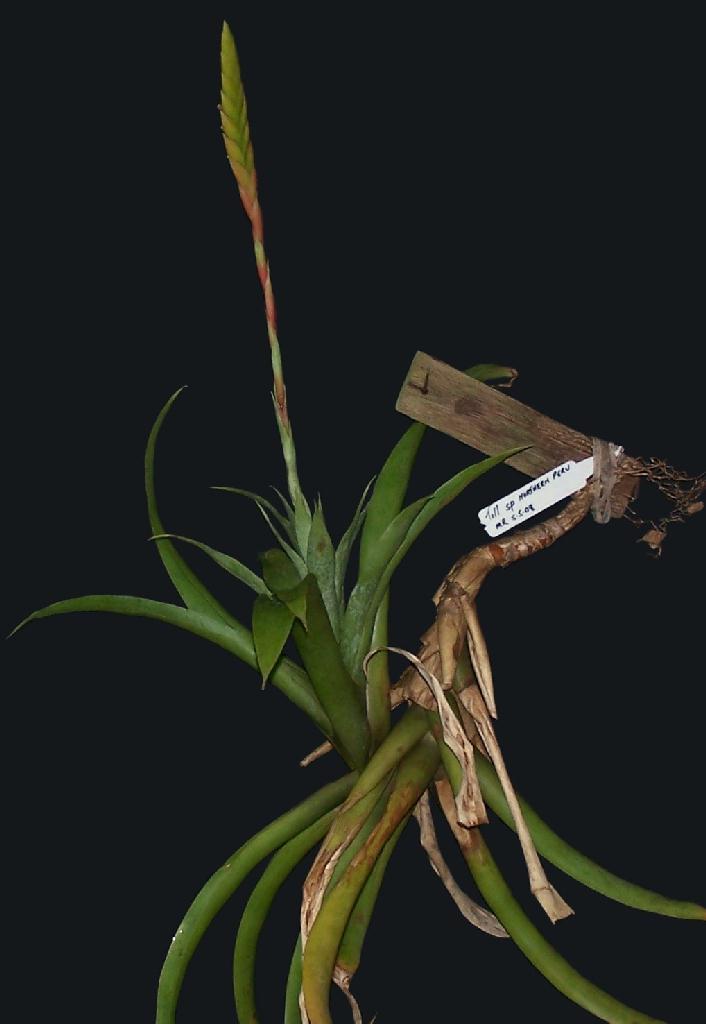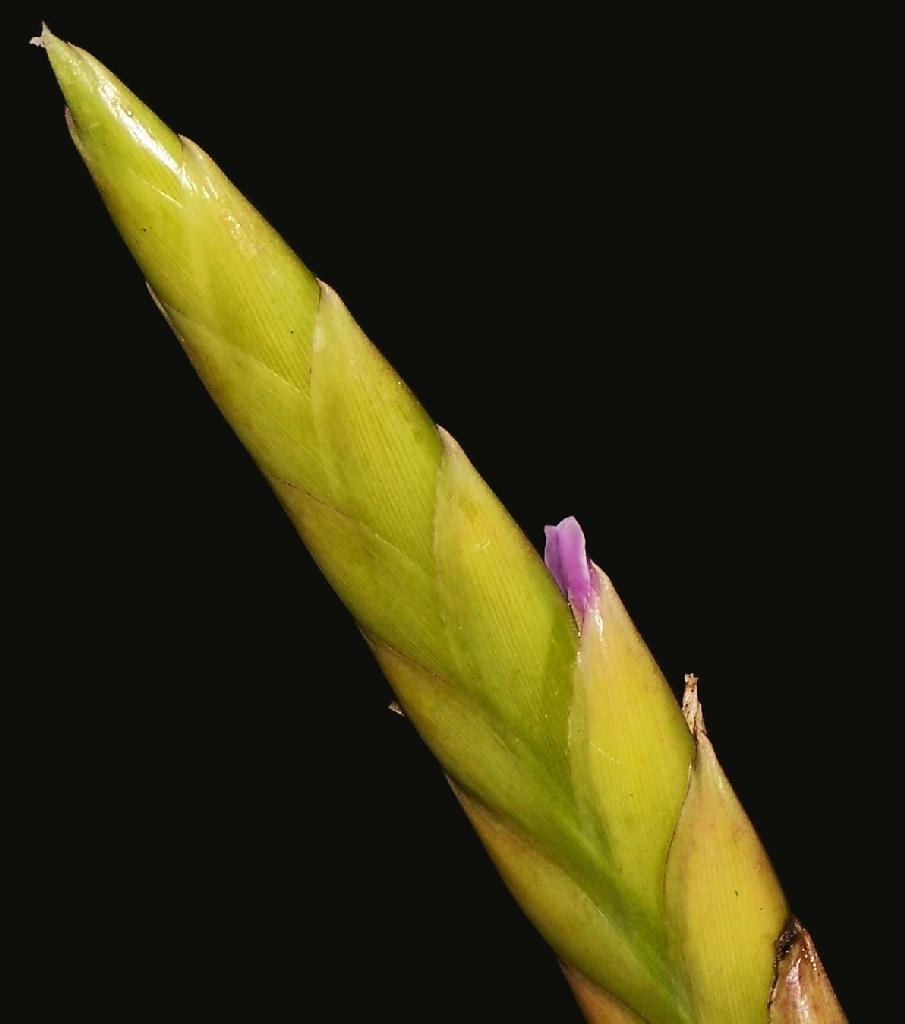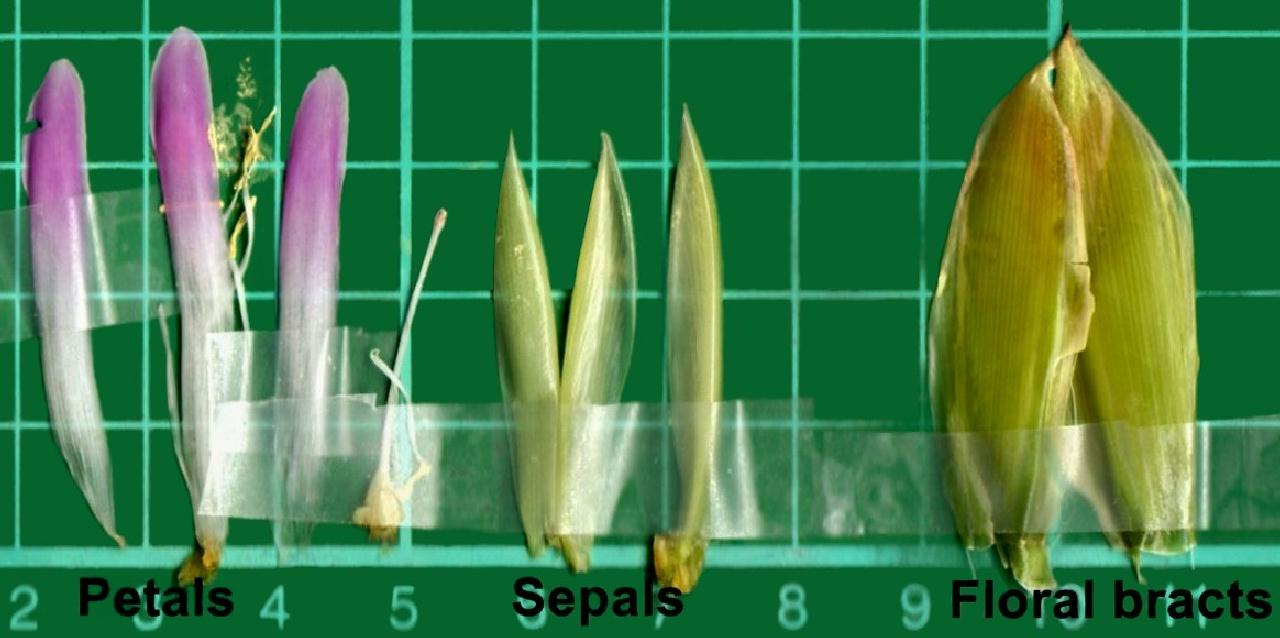Tillandsia kauffmannii
Click thumbnails for full size, scaled to a new window.
Tillandsia kauffmannii



| Mark Supple 08/11. "Species, Northern Peru, Gordon's plant." |


Tillandsia kauffmannii R. Ehlers, Trop Subtrop Pflanz 75:32-34. 1990
A Tillandsia huarazensis Ehlers & Till foliis viridibus nec cinereo-lepidotis, scapo inflorescentiae multo longiore, spicis multo longioribus et bracteis florigeris sepalisque multo majoribus differt; a T. reversa L. B. Smith caule brevi sed distincto, vaginis foliorum pallidioribus, bracteis florigeris sepalis subaequantibus, sepalis aequaliter usque ad 2mm connatis recedit.
Holotypus: R. & K. Ehlers P 78105 (1978), in herb. univ. Wien (WU).
Patria et distributio: prope Coina, Prov. Otuzco, Dptm. La Libertad, Peruvia.
Unterscheidet sich von Tillandsia huarazensis Ehlers & Till in folgenden Merkmalen: Blatter grun, nicht grau lepidot. Infloreszenzschaft, Ahren, florale Brakteen und Sepalen langer. Von T. reversa L. B. Smith weicht sie ab durch den kurzen aber deutlichen Stamm, die bleichen Blattscheiden, die fast gleichlangen floralen Brakteen und Sepalen und die gleichmassig 2mm hoch verwachsenen Sepalen.
Holotypus: R. & K. Ehlers P 78105 (1978), im Herb. Univ. Wien (WU).
Heimat und Verbreitung: in der Umgebung von Coma, Prov. Otuzco, Dptm. La Libertad, Peru.
Pflanze kurz bis 40cm lang stammbildend, bluhend bis 55cm hoch, bis 25cm breit. Blatter polystich angeordnet, eine fast aufrechte Rosette bildend. Scheiden undeutlich, bis 5cm breit und 6cm lang, oberseits glanzendbraun, unterseits gleichfarbig mit den Spreiten ; diese bis 18cm lang, 3eckig-zugespitzt, aufrecht bis spreizend, die Spitzen nach aussen gebogen, etwas canaliculat, grun mit dunkelroten Randern und Spitzen, +/- rot gefleckt, genervt, oberseits glanzend, dicht angedruckt lepidot, unterseits dicht weiglich angedruckt lepidot und etwas wachsig. Infloreszenzschaft 8-20cm lang, rund, 7mm im Durchmesser, kahl, aufrecht. Schaftbrakteen dicht imbrikat, den Schaft umfassend und verhullend, schmal-elliptisch, zugespitzt, die unteren subfoliat, die oberen nur kurz bespitzt. Infloreszenz aufrecht, die Matter uberragend, einfach oder aus bis zu 5 +/- aufrechten Ahren zusammengesetzt (Abb. 17). Primarbrakteen kurz, nie langer als 1/4 der Ahre, breit-oval, zugespitzt, den oberen Schaftbrakteen ahnlich. Ahren 5-20cm lang, bis 2cm breit, lanzettlich, zugespitzt, complanat, Rhachis nicht sichtbar, mit 5-15 sitzenden Bluten. Florale Brakteen bis 3.3cm lang, bis 2.2cm breit, breit-oval, zugespitzt, so lang oder 1mm langer als die Sepalen, etwa 3 mal so lang wie die Internodien, hart-ledrig, mit hyalinen Randern, schwach gekielt, zur Basis 2kielig, oberseits stark genervt, glanzend grun, mit kleinen, dunklen Schuppen, unterseits glanzend, an der Basis grun, zur Spitze gelbrot, kahl, nur an der hakig gebogenen Spitze wenige dunkle Schuppen (Abb. 17). Sepalen schmal-elliptisch, etwas asymmetrisch, zugespitzt, bis 3cm lang, 9mm breit, die hinteren etwas langer als das vordere, gleichmassig 2mm hoch verwachsen, ledrig, mit breiten hyalinen Randern, die hinteren alat gekielt, hellgrun, kahl, genervt. Petalen die floralen Brakteen nur um 5-7mm uberragend, zungenformig, etwas zugespitzt, eine aufrechte Rohre bildend, die Spitzen nicht auseinanderweichend, 3.5cm lang, 5-6mm breit, hellviolett bis rosa, die Spitzen etwas heller, an der Basis weiss. Staubblatter fast so lang wie die Kronrohre, jedoch nicht sichtbar. Filamente bis 3.5cm lang, weiss, dunn, bandformig, im unteren Teil gedreht und aneinanderklebend, jedoch nicht gefaltet. Antheren 4-5mm lang, 0.75mm breit, subbasifix, sagittat, olivgelb; Pollen zitronengelb. Griffel etwas kurzer als die Filamente, 2.2cm lang, weiss, dunn; Narbe 3mm hoch, 3mm breit, Loben spreizend, weiss, stark papillos. Ovarium 5mm hoch, 3mm breit, elliptisch, hellgrun.
Ausser am Typstandort wurde die Pflanze von R. & K. Ehlers noch in der Provinz Huaraz, Dptm. Ancash gesammelt. In den Botanischen Garten Linz und Wien befinden sich ebenfalls Exemplare von T. kauffmannii, deren Herkunft mit Nordperu angegeben ist.
Zu Ehren von Dr. Oswaldo Kauffmann, der in Coina eine Klinik zur Behandlung von Tropenkrankheiten aufgebaut hat.
Translated by Butcher
Plant with stem short to 40cm long, flowering to 55cm high, to 25cm wide, Leaves polystichous arranged, making an almost erect rosette.
Leaf sheath indistinct, to 5cm wide and 6cm long, topside shiny brown, underneath same colour as blade.
Leaf blade to 18cm long, triangular acuminate, erect to spreading, the tip bent outwards, channelled, green with dark red edges and tips, ca. red blotched, nerved, top side shiny, dense appressed lepidote, underneath dense whitish lepidote and waxy.
Scape 8 – 20cm long, round, 7mm diam, naked, erect.
Scape bracts densely imbricate, extensively covering the stem, thin elliptic, acuminate, the lower ones leaflike, the upper with short tips.
Inflorescence erect, exceeding the leaves, simple,or with 5 more or less erect compound spikes.
Primary bracts short, never longer than 1/4 of the spike, broad oval, acuminate, similar to the upper scape bracts.
Spike 5 – 20cm long, to 2cm wide, lancelike, acuminate, complanate.
Rhachis not visible, with 5 – 15 sessile flowers.
Floral bracts to 3.3cm long, to 2.2cm wide, broad oval, acuminate, as long or 1mm longer than the sepals, 3 times as long as the internodes, hard leathery, with transparent edges, weakly keeled, 2 keeled at base, the top side strongly nerved, shiny green, with small dark scales, the underneath shiny, at the bottom green, the tip yellowish red, the hooked tip with a few dark scales.
Sepals thin elliptic, asymmetric, acuminate, to 3cm long, 9mm wide, the posterior ones longer than than the front one, uniformly joined for 2mm, leathery, with broad transparent edges, the posterior keeled, light green, naked, nerved.
Petals exceed the floral bracts by 5 – 7mm, tongue-shaped, acuminate, making an erect tube, the tip not weakly separate, 3.5cm long, 5 – 6mm wide, light violet to pink, the tip lighter, the bottom white.
Stamens almost as long as the flower tube, however not visible,
Filament to 3.5cm long, white, thin, ribbonlike, the bottom part twisted and stuck together, however not pleated.
Anther 4 – 5mm long, 0.75mm wide, joined near the base, shaped like an arrow head, olive yellow,
Pollen lemon yellow.
Style shorter than the filament, 2.2cm long, white, thin,
Lobes 3mm high, 3mm wide, spreading, white, strongly papillose.
Ovary 5mm high, 3mm wide, elliptic, light green.
Type locality Near Coina, Prov. Otuzco, Deptm. La Libertad Peru.
Holotype R & K Ehlers P 78105 (1978), in herb.,univ. Wien (WU)
Named after Dr Oswaldo Kauffmann from the Tropical Diseases Clinic in Coina.
As well as the type locality, R. & K Ehlers also collected a plant in the Province of Huaraz, Dptm. Ancash.
Examples of T. kauffmannii may be found in the Botanical Gardens of Linz and Vienna, whose origin is stated as North-Peru.
Differs from T. huarazensis in
Leaves green not grey lepidote.
Scape, spikes, Flower bracts and Sepals longer
Differs from T. reversa in
Stem short but distinct
Leaf Sheath more paler.
Floral bracts almost equal to the sepals
Sepals equally joined for 2mm
Updated 19/01/23




